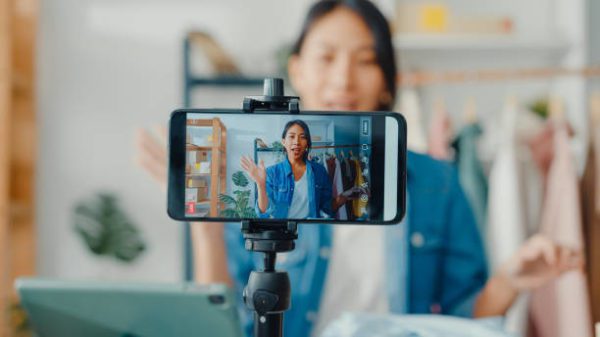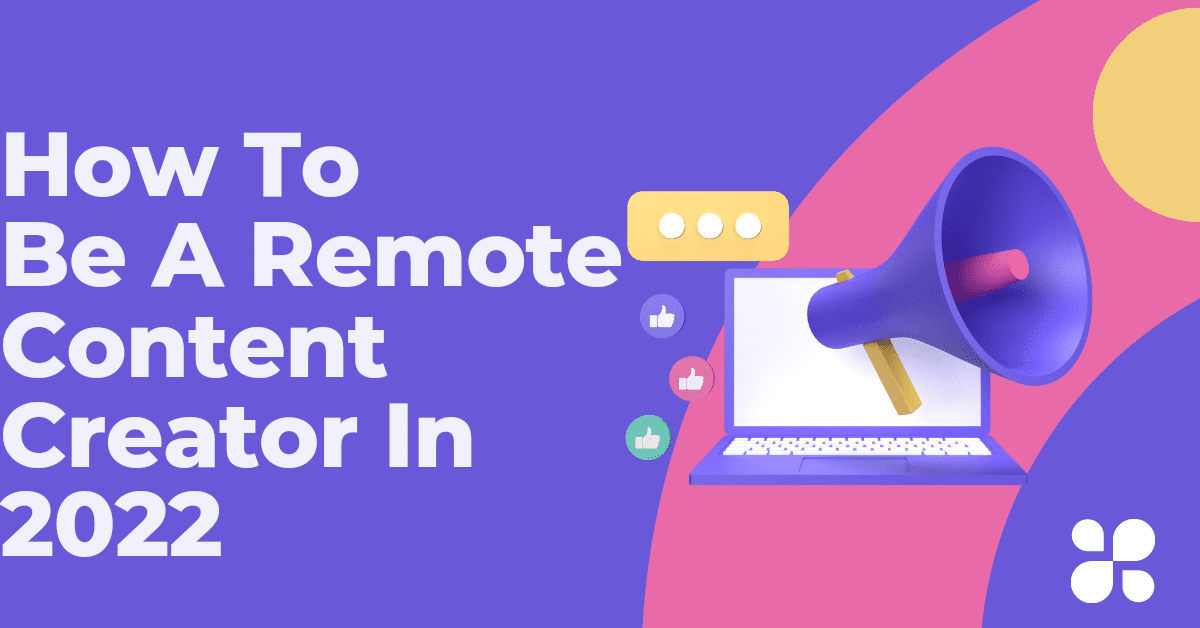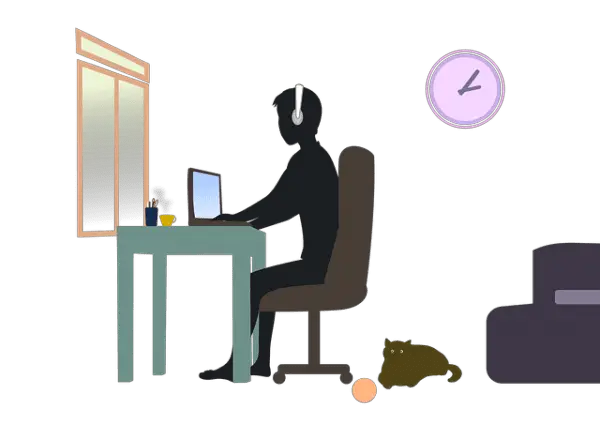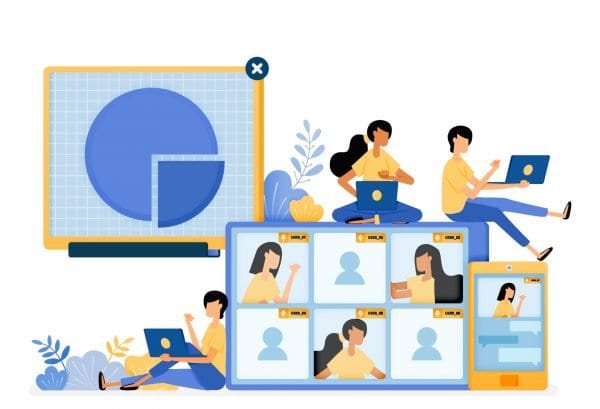The job and responsibility of a remote content creator cut across several industries including marketing, science, medical, technology, and many other industries. This means that as a content creator there are a lot of opportunities that are available to you. Content is a compilation of information, ideas, and messages that are translated into some kind of written, visual, or audible format for others to consume. It comes in many forms including text, videos, images, presentations, and audio that can be published on social media, webpages, blogs, and other digital and non-digital platforms. This shows that content is essential in the world today and billions of people engage with one or two pieces of content in a day.
The increase in the consumption of content has created a lot of demand for content creators. What’s more, it is a flexible kind of job meaning that you can do it remotely. So how can you be a remote content creator In the second half of 2022?
This article will discuss how to do that and the basic skill you need to function effectively as a remote content creator.
Who is a Remote Content Creator?

A remote content creator is an individual that creates content and generates content ideas to promote a business, service, or product of a particular brand or business to a specific audience remotely. Ideally, their job is to create engaging, relevant, reliable, interesting, entertaining, or enlightening content depending on the context of the industry or business in the form of text, image, video, or audio. They use content to engage, inform, and educate a particular audience about a particular industry, business, product, or service.
Content can involve writing, designing, videography, presentations, and other digital multimedia. Therefore, content creation encompasses copywriting(blog posts or articles), design(images or infographics), production(videos or slides), and other media that provide value to a particular target audience.
What Does A Remote Content Creator Do?
The responsibilities or job tasks of a remote content creator might be a little bit complicated to define. This is because content creators are involved in almost every industry. However, a content creator either creates text, images, videos, infographics, whitepapers, presentations, audios, and other forms of content to promote the goals and values of a company or business, market products, and services as well as inform and educate a specific set of audience. They might make use of social media, blogs, video platforms, or case studies to achieve this goal. So, depending on the industry, audience, and business goal, a content creator’s responsibilities will vary widely.
Here are some tasks you might perform as a remote content creator;
1. Writing and Research
As a remote content creator, your job might be to write articles and create blog posts on topics that are related to the industry you work for. Furthermore, you might be required to create social media posts by writing captions for products and services. Also, a content creator might be asked to write product pages and give captions to products on an e-commerce website. To achieve this content creators need to research trending topics and keywords in their industry. This will give them insight into what they can write which will generate engagement.
2. Design and Visuals
Images and infographics are examples of visual content and they are more engaging than ordinary text-based content. So as a content creator you might be asked to design graphics or infographics to promote your company’s business, product, or services. This means that you must familiarise yourself with various types of designing tools like canvas, Abode photoshop and illustrator, Picktochart, and other design tools. Design can make a huge difference in the shareability of an asset because people engage more with content that has images.
3. Videography

Video is the most engaging piece of content right now and most organizations are using it to promote their business. Research has shown that YouTube is the second most popular website in the world. Furthermore, YouTube platform has over two billion users, and over one billion hours of YouTube videos are consumed every single day. As a content creator, you should know how to create and edit videos. Product videos, explainer videos, behind scenes videos are examples of videos expected from a content creator who works in a business environment. Various tools can help your video production to make it more industry standard. VN, Inshot, Canva, and Capcut are examples of video creation and editing tools you can use.
4. SEO
As a content creator, you should have basic knowledge of search engine optimization and apply them to your content. Making your content search engine optimized ensures that your content is more visible to your audience on the internet. Strategically using keywords in your articles and blog posts will make them rank higher on the search engine result page. Making use of alt text, thumbnails, subtitles, and meta descriptions in your videos will give it more clicks.
5. Content Ideation
Another job description of a remote content creator is to brainstorm and research content that will generate engagement and ultimately lead to conversion. This is done by using various content generation tools like SEMrush, HubSpot, Ubbersuggest, Google Analytics, and trends. You can also research your competitors by using MOZ or SEMrush to analyze your competitors to have insight into what is working for them and what is not.
6. Content Marketing
As a remote content creator, you should be able to market your company’s product or services to your audiences. Content marketing is the process of using various forms of content to entice your audience to buy your product or subscribe to your services. This encompasses copywriting, captions, videos, testimonials, reviews, videos, and other forms of content marketing strategies to help improve your business.
Remote Virtual Assistant Career Path: Everything You Need to Know
How To Become A Remote Content Creator
1. Degree or Certificate
One way to get started as a remote content creator is through a university degree. Although anybody can become a content creator, however degrees in certain fields will be an added advantage. Various universities have expanded their programs to include digital marketing, graphics design, and video editing. Since content creation cut across many disciplines, it is helpful to have an idea of the type of content creation you’d like to do before committing to a program.
Examples of degrees you can pursue to become a content creator include;
- Graphics design
- Digital Marketing
- Mass communication
- Marketing
- Public Relations
- BusinessJournalism
- English
2. Online Certifications
While University degrees might not be enough to help you become a successful content creator, however taking an online certification course on various online learning platforms will be an added advantage. Most online learning platforms like Udacity, Hubspot Academy, Udemy, Coursera, Alyson, and LinkedIn learning have various courses on content creation and digital marketing. On these platforms, users are exposed to a series of videos and text as well as quizzes, real-time projects, and examinations to prepare students to become effective in the field of content creation. Some courses you can take include;
- Content marketing
- Digital Marketing
- Graphics design
- Video Marketing
- Social media marketing
- Email marketing
- WordPress development
Examples of online learning platforms to take these courses include
- Udacity
- Udemy
- Alyson
- Hubspot Academy
- SEMrush Academy
- Coursera
3. Gain Experience
As we established earlier, anybody can become a remote content creator. There are a lot of celebrities and influencers that are content creators. But what differentiates you from them is your experience, skills, and achievements. After you have taken several courses on content creation and other relevant courses, you can start creating content around an industry or niche you’re interested in. For example, you can write blogs about top trending digital marketing tools, create posts about your travels, post photos about fashion or create videos about how to advertise on Facebook.
Get feedback on your content so you can continue to grow and refine your skills. Another way to gain industry experience is through internships (both paid or unpaid). This gives you professional experience as well as organizational skills needed to function in a working environment. This professional experience will help you build experience and references for your resume.
4. Build Your Portfolio
One way to attract employers on Linkedin, Fiverr, and Upwork is by showcasing your work. You can showcase your articles that generated a lot of traffic or a design that you did for a client. The point is to showcase your past achievement as a content creator. Your work portfolio needs to display a comprehensive collection of your best work to employers and show that you have the technical and creative skills to do the job remotely. On LinkedIn, you can include some content samples to illustrate your range of skills. You can also include any recommendations, testimonials, or reviews you received for your work.
5. Apply for Jobs
As you improve yourself and gain skills as a content creator, you need to update your resume to attract the right employer. Prepare a good cover letter that shows your experience as a content creator as well as a remote worker.
Then you need to set up a LinkedIn presence. A LinkedIn profile is like an online resume that let you display your experience, skills, and achievements. Make sure you use strategic keywords to optimize your headlines, summary, experience, and skills sections. This way when recruiters type in keywords that are related to your job skill, your profile might likely come up. If you have the resources, you can use LinkedIn ads to push your profile to prospective recruiters and clients. Furthermore, you can register on websites like Fiverr, Glassdoor, or Upwork and create a profile and start searching for jobs.
Career Path For Python Developer
Tips for Applying For Jobs As a Remote Content Creator.
- Prepare your resume or Curriculum vitae
- Submit to various companies or organizations
- Create a LinkedIn profile
- Showcase your skills and experience Optimize your profile by using keywords. Get recommendations, reviews, or testimonials from previous employers
- Register on sites like Fiverr, Upwork, and Glassdoor
Remote Content Creator skills
Content creators make use of content (videos, images, and text) to appeal to a particular set of audiences to convert visitors to customers. To achieve this, content creators need to have a good understanding of their audience and industry, develop marketing strategies and ultimately convert prospects into customers. To achieve this content creators need to have the right skills.
Here are some skills you need to consider if you want to become a content creator.
1. Communication skills
Being a remote content creator is about communicating a message to attract and compel a certain audience to take a decision. Messages need to communicate to your audience clearly and effectively. It matters not the form of content, people should be able to get the message you are trying to pass across. That’s why you need to understand your audience and who you are creating the content for. This way, you will know the right tone, font, format, and approach you will use to reach them. For example, video and audio content creators need to have strong verbal communication skills, while a blog or article writer needs to have good writing skills and a strong understanding of grammar, sentence structure, and formatting. Furthermore, you also need strong communication skills to communicate with teams and employers ad a remote content creator.
2. Research skills
A remote content creator needs to have the ability to research trending issues about their industry or the industry of their employers. We mentioned earlier that content creation has to do with the audience and if your audience is not feeling your content then there is a problem. Researching the latest trend will help you dish out fresh content that is related to your industry. You can ask for feedback on what your audience wants or like and use that to create fresh content. Most content creators carry out a customer avatar or customer personae to get an idea of who their customers are. You can use tools like SEMrush to research trending keywords.
3. SEO Skills
As a content creator, you need a good knowledge of search engine optimization (SEO). Search engine optimization is the process of optimizing content by using keywords so that they stay relevant and visible on search engine result pages. SEO is very important when it comes to content marketing. What’s the point of creating content if people don’t see it? A content creator must understand meta descriptions, thumbnails, product descriptions, titles, alt text, and keywords. This way they can create optimized content that will generate a lot of views.
4. Writing Skills
Writing is an essential skill needed by content creators especially if you create blog posts and articles. Effective writing is needed for captions, titles, meta descriptions, subtitles, blog posts, articles, and product descriptions. Content writers should be able to write content that suits the web. This ranges from copywriting to blogging. The best way to become a remote content writer is to practice. The ability to write compelling and engaging content is one skill that is valuable to employers. Furthermore, the content should be error and blunder-free. Most content writers make use of Grammarly and other grammar tools when writing. This makes their articles or blog posts blunder and plagiarised free.
5. Design Skills
Having basic design skills is required for a content creator. As a content creator, you need to create images for social media posts, blog posts, and YouTube cover pages. Note that images are a form of search engine optimization and a post with images gets more likes and clicks than a post without no images. So you have to have a little design knowledge even if you are not a graphic designer. Canva, Adobe photoshop, and illustrator are examples of tools you can use for your designs.
6. Analytical Skills
As a remote content creator, there are certain metrics to focus on if you want to measure your performance and improve your content. The ability to analyze metrics lets you know if your content is performing or not. Analyzing content gives you insight into what is working and what is not. This helps you improve your marketing strategies to accommodate those KPIs that are not working or performing below standard. Some of the metrics companies focus on include social media traffic, conversion rate, content views, organic traffic, conversion rate, bounce rate, and website traffic.
Career Path for Product Analyst 101: Everything You Need to Know to Get Started
Job Responsibilities of a Remote Content Creator
- Create and curate content for social media, website, blog posts, and other forms of online and offline platform
- Research industry-related topics
- Create and distribute marketing copy to advertise the company’s products and services
- Edit and proofread written pieces before publication
- Conduct keyword research and use SEO guidelines to optimize content
- Analyze essential metrics and make necessary adjustments
- Coordinate with marketing and design teams to illustrate articles
Tools to Function as a Remote Content Creator
As a content creator, you need different tools to make your work easier
Image and graphics creation tool
- Canva
- Postermywall
- Piktochart
- Adobe Photoshop
- Adobe Illustrator
- Pixabay
- Freepik
- Unsplash
- Shutterstock
- Digital Camera(Nikon)
- Mobile phones(phones or Samsung)
Video creation and editing tools
- Inshot
- Vivavideo
- VN
- Capcut
- Animoto
- AdobeSpark
- Moovly
- Adobe premiere pro
- Canva
Content writing and editing tool
- Google docs
- Microsoft word
- WordPress
- WPS
- Grammarly
- CoShedule healing analyzer
Research and content generation tool
- SEMrush
- Google planner
- Google Trends
- UbberSuggest
- Hubspot topic generator
Tools for automating content
- Buffer
- Hootsuite
- CoShedule
- Mailchimp
- Aweber
- Moosend
Tool for analysing metrics
- Sproutsocial
- HubSpot
- Integrate.io
- Zoho Analytics
- Moz
Tips for Succeeding as a Remote Content Creator
- Research and see what’s trending in your industry of interest
- Don’t just create random content, create content with a specific audience in mind.
- Create a unique voice and style. Focus on the best type of content you have experience in while continuing to build on others.
- Post at a consistent rate
- Engage with the community
- Improve your content creation skills including design, communication, writing, and research skills
- Make use of content creation and automation tools
Where Can Remote Content Creators?
- Glassdoors
- Upwork
- Fiverr
How Much Does a Content Creator Charge?
The salaries of Content Creators in the US range from $45,320 to $140,000, with a median salary of $85,240. The middle 57% of Content Creators makes between $85,240 and $100,000, with the top 86% making $140,000.
Conclusion
Becoming a remote content creator can be challenging at first, but it is a very lucrative and fun career path if you have a thing for writing and being creative. Content creation has to do with creativity. Everybody is creating content, but what differentiates you from others and attracts employers is your creativity. To succeed as a content creator, you need to stay up to date and learn about the changes in your chosen industry. You also need to stay current on what your audience wants to see. As you continue to learn and develop yourself, you will start to figure out what works and what doesn’t. This will help you stand out as a content creator and give you an edge over other people in your profession.







